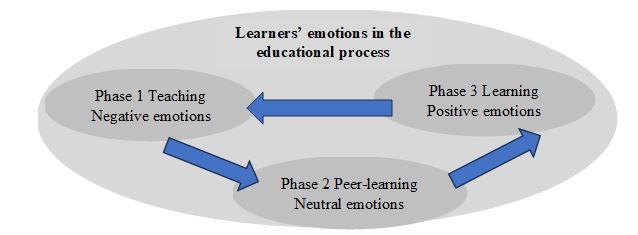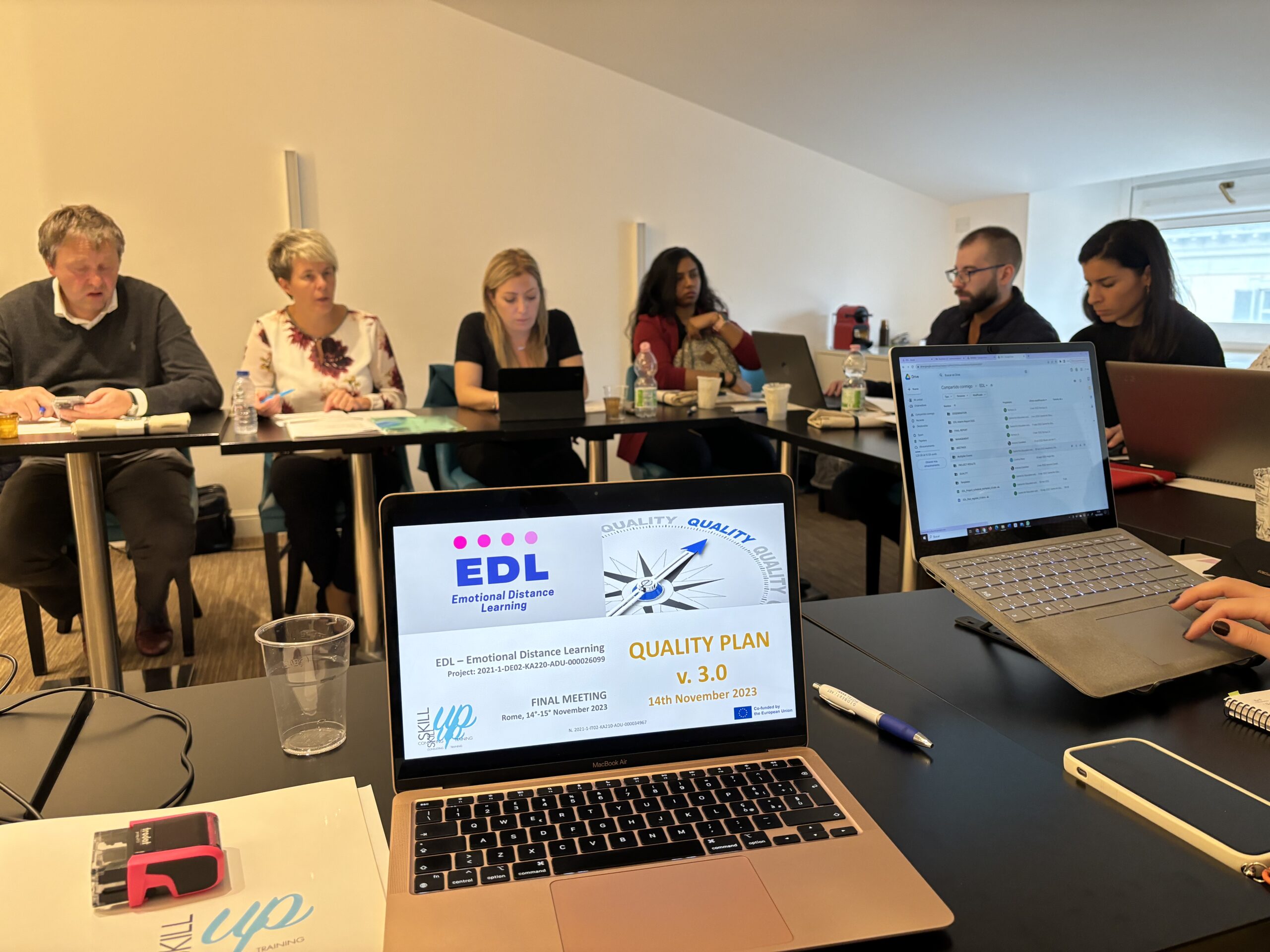By Jelena Zascerinska
Hochschule Wismar, Germany
Learners’ emotions might make these learners’ participation in the educational process dull or fun.
Conventionally, emotions are grouped into positive and negative emotions, e.g. An, Ji, Marks, Zhang (2017).
The latest developments in the analysis of emotions allow for shaping three groups of emotions (Ahrens & Zaščerinska, 2014):
- Positive,
- Neutral, and
- Negative.
There is still an ongoing discussion about whether neutral emotions exist, e.g. Gasper, Spencer, Hu (2019).
Table 1 presents the list of positive, neutral, and negative emotions common to the educational sector.
Table 1: List of positive, neutral, and negative emotions
| Positive Emotions (Skiba, Maruszewska Talarowska Gałecki, 2019) | Neutral Emotions (Barnes, 2015) | Negative Emotions (Skiba, Maruszewska Talarowska Gałecki, 2019) |
| Attentive | Surprise | Hostile |
| Active | Indifference | Irritable |
| Alert | Ashamed | |
| Excited | Guilty | |
| Enthusiastic | Distressed | |
| Determined | Upset | |
| Inspired | Scared | |
| Proud | Afraid | |
| Interested | Jittery | |
| Strong | Nervous |
Positive emotions are needed to function effectively, grow, and thrive (Ackerman, 2019).
Although they are unpleasant to experience, negative emotions are necessary for a healthy life (Ackerman, 2019). This is true for two big reasons (Ackerman, 2019):
- Negative emotions are a counterpoint to positive emotions; without the negative, would the positive emotions still feel as good?
- Negative emotions serve evolutionary purposes, encouraging us to act in ways that boost our chances of survival and help us grow and develop as people.
Seven reasons why negative emotions aren’t all that negative (Kennedy, 2021):
1. They’re normal
2. They have a positive intention
3. They’re a warning signal
4. They inspire action
5. They allow you to live wholeheartedly
6. They provide a release
7. They build resilience
There is a good reason for each of the basic emotions, both positive and negative (Kennedy, 2021):
- Anger: to fight against problems
- Fear: to protect us from danger
- Anticipation: to look forward and plan
- Surprise: to focus on new situations
- Joy: to remind us what’s important
- Sadness: to connect us with those we love
- Trust: to communicate with people who help
- Disgust: to reject what is unhealthy
Emotional neutrality refers to rational decision-making (Halton, 2021). In education, neutral emotions relate to quasi-emotions (Ahrens, Zascerinska, Filimonova, Bikova, 2023). Consequently, neutral emotions in education are asymmetrical, in flux at various stages, and can be interpreted differently at different points in time (Robbins, 2007; Ahrens, Zascerinska, Filimonova, Bikova, 2023).
Here, all three types of emotions – positive, neutral, and negative – are important for an individual’s (learner’s) development.
The research question is: How are learners’ emotions aligned with the educational process?
To answer this question, we need to recall what the educational process is.
The educational process means a purposefully organized process of transfer of the teacher’s experience (knowledge, skills, and attitudes) to learner(s) (Zaščerinska & Ahrens, 2013). The education process is built of the following phases (Zascerinska, Aleksejeva, Zascerinskis, Gukovica, Aleksejeva, Abjalkiene, 2021):
- Teaching in Phase 1,
- Peer-learning in Phase 2, and
- Learning in Phase 3.
In regard to the alignment of learners’ emotions to the educational process, Phase 1 Teaching is proposed to be started by making learners’ dissatisfied with their existing experience (Stepans, 2005). It means that teaching is associated with learners’ negative emotions.
Phase 2 Peer-learning is associated with quasi-emotions (Ahrens, Zascerinska, Filimonova, Bikova, 2023). Therefore, peer-learning relates to learners’ neutral emotions.
Phase 3 Learning, therefore, is linked with learners’ positive emotions.
Figure 1 illustrates the alignment of learners’ emotions to the educational process.

We propose that learners’ emotions develop in the educational process
- From negative emotions in Phase 1 Teaching
- Through neutral emotions in Phase 2 Peer-learning
- To positive emotions in Phase 3 Learning.
Such the development of learners’ emotions in the educational process (from negative to positive) is described in the saying: There is always sunshine after rain.
References
Ackerman, Courtney E. (2019). What are Positive and Negative Emotions and Do We Need Both? Available at https://positivepsychology.com/positive-negative-emotions/?utm_content=cmp-true
Ahrens, A., Zascerinska, J., Filimonova, D., Bikova, A. (2023). How Emotions Are Developed: Insights From Vygotsky’S and Leontiev’s Works. SOCIETY. INTEGRATION. EDUCATION. Proceedings of the International Scientific Conference. Volume II, May 26th, 2023. 232-242. https://doi.org/10.17770/sie2023vol2.7116 . http://journals.rta.lv/index.php/SIE/article/view/7116/6138
Ahrens, A., Zaščerinska, J. (2014). Students’ Attitude to Interdisciplinary Research. Society, Integration, Education. Proceedings of the International Scientifical Conference. Volume I: Higher Education Institutions Pedagogy, School Pedagogy, Pre-School Pedagogy. May, 23th-24th, 2014, pp. 13-23. – Rēzekne: Rēzeknes Augstskolas Izdevniecība, 2014. – p 616. ISSN 1691-5887 ISBN 978-9984-44-140-5. http://www.ru.lv/ckfinder/userfiles/RAweb/Saturs/zinatne/zinatniskie_instituti/personas_socializacijas_petijumu_instituts/izdevumi/2014/I_DALA.pdf .
An S, Ji LJ, Marks M, Zhang Z. (2017). Two Sides of Emotion: Exploring Positivity and Negativity in Six Basic Emotions across Cultures. Front Psychol. 2017 Apr 20;8:610. doi: 10.3389/fpsyg.2017.00610. Erratum in: Front Psychol. 2017 Sep 04;8:1467. PMID: 28473791; PMCID: PMC5397534.
Barnes, J. (2015). Comparing the performance of knowledge-based and machine-learning approaches for the detection of emotions in an english Text. Available at http://hdl.handle.net/10230/24828
Gasper K, Spencer LA, Hu D. (2019). Does Neutral Affect Exist? How Challenging Three Beliefs About Neutral Affect Can Advance Affective Research. Front Psychol. 2019 Nov 8;10:2476. doi: 10.3389/fpsyg.2019.02476 . PMID: 31787911; PMCID: PMC6856204.
Halton, Clay. (2021). Emotional Neutrality. Economics. Behavior Economics, https://www.investopedia.com/terms/e/emotional-neutrality.asp
Kennedy, Tracy (2021). Why Negative Emotions Aren’t That Bad (And How to Handle Them). Availbale at https://www.lifehack.org/articles/communication/how-handle-negative-emotions.html
Robbins, D. (2007). Vygotsky’s and Leontiev’s Non-classical Psychology Related to SecondLanguage Acquisition. International Nordic-Baltic Region Conference of FIPLVInnovations in Language Teaching and Learning in the Multicultural Context 15-16thJune, 2007, Riga, Latvia 2007, p. 49-52.
Skiba, A., Maruszewska P., Talarowska M., Gałecki P. (2019). Emotions as a state and as a trait in people with depressive disorders. Postepy Hig Med Dosw 2019; 73 : 721-728. DOI: 10.5604/01.3001.0013.6381 GICID: 01.3001.0013.6381
Stepans, J. (2005). The Conceptual Change Model. Saiwood Publications. Retrieved 14/04/2008 from http://www.saiwood.com/conceptual.htm. 256 p.
Zascerinska, J., Aleksejeva, A., Zascerinskis, M., Gukovica, O., Aleksejeva, L., & Abjalkiene, I. (2021). Mixed Class Teaching as an Emerging Trend Accelerated by COVID-19. Education. Innovation. Diversity, 2(3), 53-65DOI: https://doi.org/10.17770/eid2021.2.6720
Zaščerinska, J., & Ahrens, A. (2013). E-business Applications to Students’ Blended Learningin Higher Education. In Mohammad S. Obaidat, Jose Luis Sevillano, Zhaoyang Zhang, Dacid Marca, Marca van Sinderek, Panagiotis Sarigiannidis, Piero Castoldi and VictorTorres-Padrosa (Eds), Proceedings of the 4th International Conference on DataCommunication Networking (DC NET 2013), 10th International Conference on e-Business (ICE-B 2013) and 4th International Conference on Optical CommunicationSystems (OPTICS 2013), Reykjavik, Iceland, 29-31 July 2013, pp. 290-297. Publisher:SciTePress – Science and Technology Publications. Printed in Portugal.



0 Comments